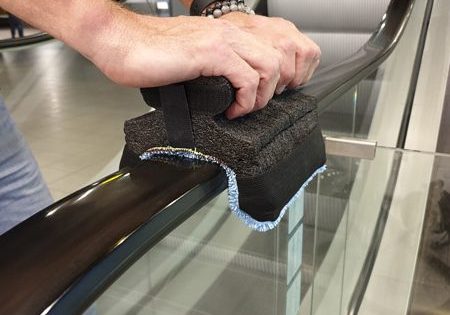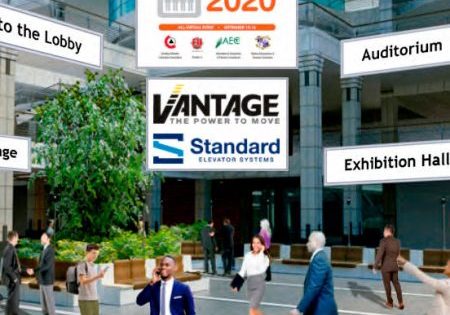National Elevator Industry: From 2020 Review to 2021 Vision
Dec 1, 2020

Your author, NEII’s new executive director, assesses the state of the vertical-transportation industry and the “new normal.”
Stepping into the National Elevator Industry, Inc.’s (NEII) executive director role in mid-October (p. 20) offered me a chance to both look ahead with fresh eyes to the industry’s goals and reflect on the challenges and opportunities we experienced in 2020.
A Look Back at 2020
In early March, several of NEII’s key committees convened in West Palm Beach, Florida. By that time, the coronavirus had become a topic of discussion, but none of us knew just how much it would impact the industry and our lives for the remainder of the year. Within a week of those meetings, many businesses and schools closed or operated remotely, buildings were shuttered, and borders began to shut down. Jobs were classified as essential or nonessential, and elevator work in all jurisdictions was forced to adapt to meet the new challenges.
Federal, state and local governments scrambled to manage the response. NEII’s team jumped into high gear; analyzed stay-at-home and executive orders from every jurisdiction; and worked with mayors and governors across the country to ensure all elevator work was deemed “essential,” regardless of the classification of the building or industry in which it occurred. We convened a forum of the industry’s safety directors to compare notes on a wide range of pressing issues, including the difficulties in procuring much-needed masks, gloves and other personal protective equipment; creative ways to assemble portable handwashing stations; and risk-mitigation strategies for working in high-risk buildings.
NEII also took the lead in developing “best practices” for the riding public and for facility managers based on the guidance issued by the World Health Organization and Centers for Disease Control and Prevention (CDC). And, to ensure all information and resources were readily available, NEII quickly built a dedicated website (neii.org) accessible to everyone. Having been upgraded in 2019, it proved to be an invaluable resource to keep our members and the public informed about North America’s response to COVID-19.
As the world adapted to the new safety protocols with regard to the pandemic, buildings, businesses and economies slowly started to reopen. NEII once again took a leadership role to analyze every executive order, policy and directive, and to effectively communicate the key information to our members. Additional guidance was created to assist facility managers in handling the flood of people returning to their buildings and to proactively engage the media to dispel fears of riding in elevators by sharing tips every passenger should know to mitigate exposure. The message is clear: an elevator should be used with the same precautions as any other public space to maximize safety by maintaining social distance, wearing face masks and washing hands or using hand sanitizer after riding.
The critical partnerships forged and strengthened by NEII throughout the pandemic response will be serving the industry for years to come. The U.S. Cybersecurity and Infrastructure Security Agency’s Essential Critical Infrastructure Workers Guidance Version 4.0, related to such infrastructure and essential workers, now includes additional references to the building transportation industry because of NEII’s work to secure those qualifications. NEII staff also worked with the CDC and the National Institute for Occupational Safety and Health to ensure consistency on guidance related to elevator and escalator use. Not only do the current tools enhance our industry efforts, but NEII is positioned to partner with these organizations when updates and revisions are undertaken.
As we move forward with COVID-19 recovery and settle into the “new normal” of how we go about our lives, the elevator industry is anticipating the changing needs of architecture and buildings and is already innovating in response to post-pandemic demands. “Touchless” systems, destination dispatch, and other remote functionalities are likely to be utilized in more markets and may ultimately become the norm for getting people safely and efficiently to their floors. And, NEII will continue to push for regulatory and code development efforts to support innovation and technology.
NEII’s team jumped into high gear; analyzed stay-at-home and executive orders from every jurisdiction; and worked with mayors and governors across the country to ensure all elevator work was deemed “essential,” regardless of the classification of the building or industry in which it occurred.
In a year clouded by the tragedies and fear caused by the pandemic, the nimbleness and innovative spirit of the elevator industry has been a bright spot. The industry came together to find ways to work through the obstacles and protect the safety of its workforce and the riding public.
The critical partnerships forged and strengthened by NEII throughout the pandemic response will be serving the industry for years to come.
Looking Ahead to 2021
At NEII, we are looking forward to building on the spirit of collaboration and leadership our industry showed during the pandemic into 2021 and beyond. Our advocacy focus will remain strong as we continue to advance safety, promote the adoption of the most recent codes and protect innovation across the industry. Other areas we are looking to expand and emphasize in 2021 include:
- Securing the adoption of technologies that support social distancing and other protocols that surfaced as part of the COVID-19 response
- Strengthening communication and partnership with jurisdictions, elevator boards and other stakeholders in the industry to help develop real, lasting solutions
- A continued commitment to providing guidance to building owners and managers, developers and riders, on the challenges they’re facing
- Enhancing the accessibility and depth of web resources, like the CodeFinder database, the NEII-1 best practices and guidelines for the building transportation industry, and a map to provide direct access to all state information.
NEII began its transition to a fully staffed and modern trade association only four years ago. When I look back on the progress we have made to advance our industry’s goals, I am proud to have been a part of it. Now, as NEII’s leader, it is my responsibility to look forward and drive the industry to new heights with the help of our staff and team of industry leaders supporting our efforts.
Amy Blankenbiller is executive director of NEII. Prior to joining NEII, she founded AjB Strategies, a political, government affairs and event management consulting firm. She also served as president and CEO of the Kansas Chamber of Commerce. Prior to that, she spent 20 years in Washington, D.C., as a senior associate at Waterman & Associates and as legislative director for the National Association of Homebuilders. She also worked for President George H.W. Bush, Sen. Bob Dole and Rep. Bob Whittaker. She holds an undergraduate degree from the University of Kansas. Before becoming NEII executive director, she served as the organization’s vice president of Government Affairs.
Get more of Elevator World. Sign up for our free e-newsletter.









